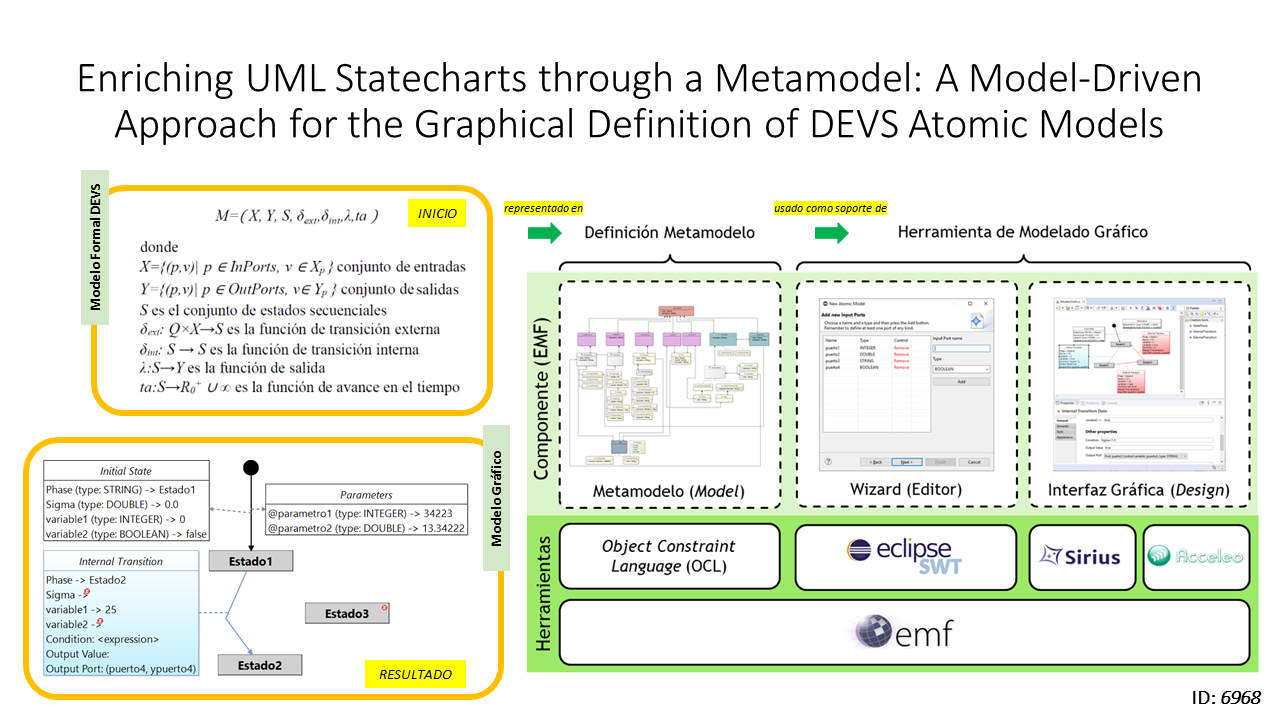Enriching UML Statecharts through a Metamodel: A Model Driven Approach for the Graphical Definition of DEVS Atomic Models
Keywords:
Discrete Event System Specification, Modeling and Simulation, Theory and Practice, State DiagramAbstract
The Discrete Event System Specification (DEVS) formalism provides a set of mathematical elements for modeling time-varying systems. However, when DEVS models are implemented in an executable representation (i.e., using a general-purpose programming language), some deviation from the formalism is unavoidable. One way to bridge the gap between modeling and simulation theory and practice is to define new artifacts that support both views during the specification. When the specification is supported with a graphical representation, the formalization task is less complex and can be performed by non-expert modelers. For DEVS atomic models, most common graphical representation is through UML statecharts. In this paper, we present a theoretical and practical metamodel for the definition of atomic models structured following the Classic DEVS with Ports formalization. Such a metamodel is the core of a model-driven approach used to develop a modeling software tool that employs enriched UML statecharts for the graphical representation of the DEVS behavior. In here, the traditional UML statechart representation is enriched with a set of new components with the aim to provide a broad definition of DEVS atomic models. The final software tool is deployed as a plugin for Eclipse Platform.
Downloads
References
G. A. Wainer, Discrete-event modeling and simulation: A practitioner's approach. CRC Press, 2009.
B. Zeigler, A. Muzy, and E. Kofman, Theory of modeling and simulation: discrete event & iterative system computational foundations, 3rd ed. Academic Press, 2018.
Y. Van Tendeloo, and H. Vangheluwe, “Classic DEVS modelling and simulation”, in WSC, Las Vegas, NV, USA, 2017, pp. 644-658). DOI: 10.1109/WSC.2017.8247822.
OMG unified modeling language version 2.5.1, OMG, 2017. [Online]. Available: https://www.omg.org/spec/UML/2.5.1
Eclipse, Eclipse foundation. [Online]. Available: https://www.eclipse. org/, Accessed on: Feb. 6, 2021
Eclipse modeling project, Eclipse foundation. [Online]. Available: https://www.eclipse.org/modeling/, Accessed on: Feb. 6, 2021
M. J. Blas, S. Gonnet, and B. Zeigler, “Towards a universal representation of DEVS: a metamodel-based definition of DEVS formal specification”, in ANNSIM, Fairfax, VA, USA, 2021. DOI: 10.23919/ANNSIM52504.2021.9552162.
M. J. Blas, S. Gonnet, and H. Leone, “Modeling User Temporal Behaviors Using Hybrid Simulation Models”, IEEE Latin America Transactions, vol. 15, no. 1, pp. 341-348, 2017, DOI: 10.1109/TLA.2017.7854631.
G. Wainer, and Q. Liu, “Tools for graphical specification and visualization of DEVS models”, Simulation, vol. 85, no. 3, pp. 131-158, 2009. DOI: 10.1177/0037549708101182.
J. L. Risco-Martın, S. Mittal, B. P. Zeigler, and J. de la Cruz, “From UML state charts to DEVS state machines using XML”, in MODELS, Nashville, TN, USA, 2007, pp. 35-48.
S. Garredu, E. Vittori, J. F. Santucci, and P. A. Bisgambiglia, “From state-transition models to DEVS models. Improving DEVS external interoperability using MetaDEVS: a MDE approach”, In Simultech, Reykjavík, Iceland, 2013, pp. 186-196. DOI: 10.5220/0004494401860196.
A. Gonzalez, C. Luna, R. Cuello, M. Perez, and M. Daniele, “Towards an automatic model transformation mechanism from UML state machines to DEVS models”, CLEI electronic journal, vol. 18, no. 2, paper 3, 2015. DOI: 10.19153/cleiej.18.2.3.
MS4 Me. Discrete event systems specification (DEVS) modeling environment. [Online]. Available: http://www.rtsync.com/pages/ products/ms4me.html, Accessed on: Aug. 10, 2021
H. Praehofer, and D. Pree, “Visual modeling of DEVS-based multiformalism systems based on higraphs”, In WSC, Los Angeles, CA, USA, 1993, pp. 595-603. DOI: 10.1145/256563.256737.
R. Goldstein, S. Breslav, and A. Khan, “Informal DEVS conventions motivated by practical considerations”, in SpringSIM, San Diego, CA, USA, 2013, article 10.
Eclipse modeling framework, Eclipse foundation. [Online]. Available: https://www.eclipse.org/modeling/emf/, Accessed on: Jun. 5, 2021
Object constraint language specification version 2.4, OMG, 2014. [Online]. Available: https://www.omg.org/spec/OCL/2.4
Eclipse OCL, Eclipse foundation. [Online]. Available: https://www.eclipse.org/ocl, Accessed on: Jul. 21, 2021
Sirius, Eclipse foundation. [Online]. Available: https://www.eclipse.org/sirius, Accessed on: Jul. 21, 2021
V. Viyović, M. Maksimović, and B. Perisić, “Sirius: a rapid development of DSM graphical editor”, in INES, Tihany, Hungary, 2014. DOI: 10.1109/INES.2014.6909375.
DEVSJAVA, Arizona center for integrative modeling and simulation. [Online]. Available: https://acims.asu.edu/software/devsjava/, Accessed on: Jul. 21, 2021


